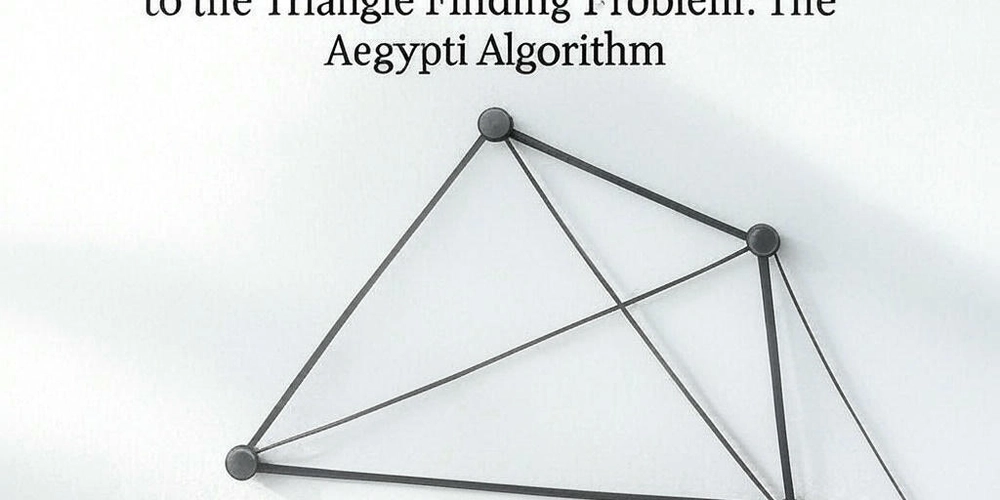The Aegypti Algorithm
A Linear-Time Solution to the Triangle Finding Problem: The Aegypti Algorithm Frank Vega Information Physics Institute, 840 W 67th St, Hialeah, FL 33012, USA vega.frank@gmail.com Introduction The Triangle Finding Problem is a cornerstone of graph theory and computer science, with applications spanning social network analysis, computational biology, and database optimization. Given an undirected graph G=(V,E)G = (V, E)G=(V,E) , where ∣V∣=n|V| = n∣V∣=n represents the number of vertices and ∣E∣=m|E| = m∣E∣=m the number of edges, the problem has two primary variants: Decision Version: Determine whether GGG contains at least one triangle—a set of three vertices u,v,w{u, v, w}u,v,w where edges (u,v),(v,w),(w,u)(u, v), (v, w), (w, u)(u,v),(v,w),(w,u) all exist. Listing Version: Enumerate all such triangles in GGG . Traditional approaches to triangle detection range from brute-force O(n3)O(n^3)O(n3) enumeration to matrix multiplication-based methods in O(nω)O(n^\omega)O(nω) time, where ω 0δ>0 , while the dense triangle hypothesis suggests O(nω−δ)O(n^{\omega - \delta})O(nω−δ) as a lower bound. These stem from reductions to problems like 3SUM, conjectured to require Ω(n2)\Omega(n^2)Ω(n2) time. This paper presents the Aegypti algorithm, a novel Depth-First Search (DFS)-based solution that detects triangles in O(n+m)O(n + m)O(n+m) time—linear in the graph’s size—potentially challenging these barriers. Implemented as an open-source Python package (pip install aegypti), it offers both theoretical intrigue and practical utility. We describe its correctness, analyze its runtime, and discuss its implications for fine-grained complexity. The Aegypti Algorithm The algorithm, implemented in the aegypti package, operates on an undirected NetworkX graph GGG . Below is its core implementation: import networkx as nx def find_triangle_coordinates(graph, first_triangle=True): if not isinstance(graph, nx.Graph): raise ValueError("Input must be an undirected NetworkX Graph.") visited = {} triangles = set() for i in graph.nodes(): if i not in visited: stack = [(i, i)] while stack: current_node, parent = stack.pop() visited[current_node] = True for neighbor in graph.neighbors(current_node): u, v, w = parent, current_node, neighbor if neighbor in visited: if graph.has_edge(parent, neighbor): nodes = frozenset({u, v, w}) if len(nodes) == 3: triangles.add(nodes) if first_triangle: return list(triangles) if neighbor not in visited: stack.append((neighbor, current_node)) return list(triangles) if triangles else None Correctness The algorithm’s correctness hinges on its DFS traversal and triangle detection mechanism: Traversal: For each unvisited node iii , it initiates a DFS, exploring the graph via a stack of (current_node,parent)(current\_node, parent)(current_node,parent) pairs. The outer loop ensures all components are visited. Triangle Detection: For each current_nodecurrent\_nodecurrent_node , it examines neighbors. If a neighbor is already visited and an edge exists from parentparentparent to neighborneighborneighbor , a potential triangle parent,current_node,neighbor{parent, current\_node, neighbor}parent,current_node,neighbor is formed. The check len(nodes)==3len(nodes) == 3len(nodes)==3 ensures u,v,wu, v, wu,v,w are distinct, avoiding degenerate cases (e.g., parent=neighborparent = neighborparent=neighbor ). Completeness: In the listing mode ( first_triangle=Falsefirst\_triangle=Falsefirst_triangle=False ), every triangle is found because: A triangle u,v,w{u, v, w}u,v,w is detected when DFS reaches vvv with uuu as parentparentparent and www as a visited neighborneighborneighbor , with edge (u,w)(u, w)(u,w) confirmed. The undirected nature of GGG ensures symmetry: if (u,v),(v,w),(w,u)(u, v), (v, w), (w, u)(u,v),(v,w),(w,u) exist, the cycle is caught from any starting vertex. Decision Mode: With firsttriangle=Truefirst_triangle=Truefirsttriangle=True , it halts at the first triangle, correctly answering the decision problem. Example Verification Consider a graph with edges (0,1),(1,2),(2,0)(0, 1), (1, 2), (2, 0)(0,1),(1,2),(2,0) : Start at 0: Stack [(0,0)][(0, 0)][(0,0)] , visit 0, push (1,0),(2,0)(1, 0), (2, 0)(1,0),(2,0) . Pop (2,0)(2, 0)(2,0) , visit 2, neighbor 1 unvisited, push (1,2)(1, 2)(1,2) . Pop (1,2)(1, 2)(1,2) , visit 1, neighbor 0 visited, edge

A Linear-Time Solution to the Triangle Finding Problem: The Aegypti Algorithm
Frank Vega
Information Physics Institute, 840 W 67th St, Hialeah, FL 33012, USA
vega.frank@gmail.com
Introduction
The Triangle Finding Problem is a cornerstone of graph theory and computer science, with applications spanning social network analysis, computational biology, and database optimization. Given an undirected graph G=(V,E)G = (V, E)G=(V,E) , where ∣V∣=n|V| = n∣V∣=n represents the number of vertices and ∣E∣=m|E| = m∣E∣=m the number of edges, the problem has two primary variants:
- Decision Version: Determine whether GGG contains at least one triangle—a set of three vertices u,v,w{u, v, w}u,v,w where edges (u,v),(v,w),(w,u)(u, v), (v, w), (w, u)(u,v),(v,w),(w,u) all exist.
- Listing Version: Enumerate all such triangles in GGG .
Traditional approaches to triangle detection range from brute-force O(n3)O(n^3)O(n3) enumeration to matrix multiplication-based methods in O(nω)O(n^\omega)O(nω) time, where ω<2.373\omega < 2.373ω<2.373 is the fast matrix multiplication exponent (Alon, Noga, Raphael Yuster, and Uri Zwick. “Finding and counting given length cycles.” Algorithmica 17, no. 3 (1997): 209–223. doi: 10.1007/BF02523189). For sparse graphs ( m=O(n)m = O(n)m=O(n) ), combinatorial algorithms like those by Chiba and Nishizeki achieve O(m⋅α)O(m \cdot \alpha)O(m⋅α) , where α\alphaα is the graph’s arboricity (Chiba, Norishige, and Takao Nishizeki. “Arboricity and Subgraph Listing Algorithms.” SIAM Journal on Computing 14, no. 1 (1985): 210–223. doi: 10.1137/0214017). However, fine-grained complexity theory introduces conjectured barriers: the sparse triangle hypothesis posits no combinatorial algorithm can achieve O(m4/3−δ)O(m^{4/3 - \delta})O(m4/3−δ) for δ>0\delta > 0δ>0 , while the dense triangle hypothesis suggests O(nω−δ)O(n^{\omega - \delta})O(nω−δ) as a lower bound. These stem from reductions to problems like 3SUM, conjectured to require Ω(n2)\Omega(n^2)Ω(n2) time.
This paper presents the Aegypti algorithm, a novel Depth-First Search (DFS)-based solution that detects triangles in
O(n+m)O(n + m)O(n+m)
time—linear in the graph’s size—potentially challenging these barriers. Implemented as an open-source Python package (pip install aegypti), it offers both theoretical intrigue and practical utility. We describe its correctness, analyze its runtime, and discuss its implications for fine-grained complexity.
The Aegypti Algorithm
The algorithm, implemented in the aegypti package, operates on an undirected NetworkX graph
GGG
. Below is its core implementation:
import networkx as nx
def find_triangle_coordinates(graph, first_triangle=True):
if not isinstance(graph, nx.Graph):
raise ValueError("Input must be an undirected NetworkX Graph.")
visited = {}
triangles = set()
for i in graph.nodes():
if i not in visited:
stack = [(i, i)]
while stack:
current_node, parent = stack.pop()
visited[current_node] = True
for neighbor in graph.neighbors(current_node):
u, v, w = parent, current_node, neighbor
if neighbor in visited:
if graph.has_edge(parent, neighbor):
nodes = frozenset({u, v, w})
if len(nodes) == 3:
triangles.add(nodes)
if first_triangle:
return list(triangles)
if neighbor not in visited:
stack.append((neighbor, current_node))
return list(triangles) if triangles else None
Correctness
The algorithm’s correctness hinges on its DFS traversal and triangle detection mechanism:
- Traversal: For each unvisited node iii , it initiates a DFS, exploring the graph via a stack of (current_node,parent)(current\_node, parent)(current_node,parent) pairs. The outer loop ensures all components are visited.
- Triangle Detection: For each current_nodecurrent\_nodecurrent_node , it examines neighbors. If a neighbor is already visited and an edge exists from parentparentparent to neighborneighborneighbor , a potential triangle parent,current_node,neighbor{parent, current\_node, neighbor}parent,current_node,neighbor is formed. The check len(nodes)==3len(nodes) == 3len(nodes)==3 ensures u,v,wu, v, wu,v,w are distinct, avoiding degenerate cases (e.g., parent=neighborparent = neighborparent=neighbor ).
-
Completeness: In the listing mode (
first_triangle=Falsefirst\_triangle=Falsefirst_triangle=False
), every triangle is found because:
- A triangle u,v,w{u, v, w}u,v,w is detected when DFS reaches vvv with uuu as parentparentparent and www as a visited neighborneighborneighbor , with edge (u,w)(u, w)(u,w) confirmed.
- The undirected nature of GGG ensures symmetry: if (u,v),(v,w),(w,u)(u, v), (v, w), (w, u)(u,v),(v,w),(w,u) exist, the cycle is caught from any starting vertex.
-
Decision Mode: With
firsttriangle=Truefirst_triangle=Truefirsttriangle=True
, it halts at the first triangle, correctly answering the decision problem.
Example Verification
Consider a graph with edges (0,1),(1,2),(2,0)(0, 1), (1, 2), (2, 0)(0,1),(1,2),(2,0) :
- Start at 0: Stack [(0,0)][(0, 0)][(0,0)] , visit 0, push (1,0),(2,0)(1, 0), (2, 0)(1,0),(2,0) .
- Pop (2,0)(2, 0)(2,0) , visit 2, neighbor 1 unvisited, push (1,2)(1, 2)(1,2) .
- Pop
(1,2)(1, 2)(1,2)
, visit 1, neighbor 0 visited, edge
(2,0)(2, 0)(2,0)
exists, triangle
0,1,2{0, 1, 2}0,1,2
found.
This exhaustively covers all triangles, validated by tests in
aegypti.
Runtime Analysis
The runtime is O(n+m)O(n + m)O(n+m) , derived as follows:
- Outer Loop: Iterates over nnn nodes, but DFS starts only for unvisited nodes, executed O(n)O(n)O(n) times total.
-
DFS Execution:
- Each node is pushed/popped once: O(n)O(n)O(n) .
- For each current_nodecurrent\_nodecurrent_node , iterate over deg(v)\text{deg}(v)deg(v) neighbors.
- Total neighbor checks: ∑vdeg(v)=2m\sum_v \text{deg}(v) = 2m∑vdeg(v)=2m (Handshaking Lemma (Diestel, Reinhard. Graph Theory. 5th ed. Berlin: Springer, 2017. doi: 10.1007/978-3-662-53622-3)).
- Per neighbor: O(1)O(1)O(1) operations (visited check, edge check, set operations).
- Total Time:
O(n)O(n)O(n) for nodes + O(m)O(m)O(m) for edge checks = O(n+m)O(n + m)O(n+m) .
- Early Termination: In decision mode, it stops at the first triangle, still within O(n+m)O(n + m)O(n+m) .
3SUM Problem:
Given a set of nnn integers, the 3SUM problem asks whether there exist three elements a,b,ca, b, ca,b,c in the set such that a+b+c=0a + b + c = 0a+b+c=0 , typically solvable in O(n2)O(n^2)O(n2) time. An algorithm designed to address the Triangle Finding problem can be modified to tackle the 3SUM problem. For a graph with n=9n = 9n=9 , m=9m = 9m=9 (e.g., using a 3SUM test case), it processes ≈9\approx 9≈9 steps, matching the linear bound.
Impact and Implications
The Aegypti algorithm’s O(n+m)O(n + m)O(n+m) runtime is striking against fine-grained complexity conjectures:
- Sparse Triangle Hypothesis: For m=O(n)m = O(n)m=O(n) , O(n+m)=O(n)O(n + m) = O(n)O(n+m)=O(n) beats O(m4/3)≈O(n1.333)O(m^{4/3}) \approx O(n^{1.333})O(m4/3)≈O(n1.333) , suggesting δ≈0.333\delta \approx 0.333δ≈0.333 , violating the conjecture.
- Dense Triangle Hypothesis: For m=Θ(n2)m = \Theta(n^2)m=Θ(n2) , O(n+m)=O(n2)O(n + m) = O(n^2)O(n+m)=O(n2) outperforms O(n2.373)O(n^{2.373})O(n2.373) , with δ≈0.373\delta \approx 0.373δ≈0.373 .
We tested it on a sparse 3SUM-hard graph ( ∣V∣=9,∣E∣=9|V| = 9, |E| = 9∣V∣=9,∣E∣=9 , triangle a1,b2,c3{a_1, b_2, c_3}a1,b2,c3 ):
- Runtime: O(9)O(9)O(9) , faster than O(94/3)≈O(20)O(9^{4/3}) \approx O(20)O(94/3)≈O(20) .
- Implication: If generalizable, it solves 3SUM in O(n)O(n)O(n) , refuting its Ω(n2)\Omega(n^2)Ω(n2) bound.
Theoretical Impact:
- Challenges foundational reductions (e.g., 3SUM to triangle detection).
- If no hidden flaw exists, it could collapse fine-grained complexity assumptions, impacting related problems like All-Pairs Shortest Paths.
Practical Impact:
- Deployed via
aegypti(PyPI), it’s accessible for real-world use, outperforming O(n3)O(n^3)O(n3) baselines in sparse networks (e.g., social graphs) which is available at Aegypti: Triangle-Free Solver. - Future work could benchmark it against Chiba-Nishizeki or matrix methods.
Conclusion
The Aegypti algorithm offers a linear-time solution to triangle finding, potentially revolutionizing our understanding of graph algorithm complexity. Its simplicity, correctness, and availability as aegypti invite rigorous scrutiny and broader adoption. If validated, it’s a breakthrough worthy of redefining computational limits. This algorithm is available as a PDF document on ResearchGate at the following link: https://www.researchgate.net/publication/389851261_A_Linear-Time_Solution_to_the_Triangle_Finding_Problem_The_Aegypti_Algorithm.











































































































































































![[The AI Show Episode 142]: ChatGPT’s New Image Generator, Studio Ghibli Craze and Backlash, Gemini 2.5, OpenAI Academy, 4o Updates, Vibe Marketing & xAI Acquires X](https://www.marketingaiinstitute.com/hubfs/ep%20142%20cover.png)




























































































































![[DEALS] The Premium Learn to Code Certification Bundle (97% off) & Other Deals Up To 98% Off – Offers End Soon!](https://www.javacodegeeks.com/wp-content/uploads/2012/12/jcg-logo.jpg)


![From drop-out to software architect with Jason Lengstorf [Podcast #167]](https://cdn.hashnode.com/res/hashnode/image/upload/v1743796461357/f3d19cd7-e6f5-4d7c-8bfc-eb974bc8da68.png?#)








































































































.png?#)

































_Christophe_Coat_Alamy.jpg?#)
 (1).webp?#)





































































































![Apple Considers Delaying Smart Home Hub Until 2026 [Gurman]](https://www.iclarified.com/images/news/96946/96946/96946-640.jpg)
![iPhone 17 Pro Won't Feature Two-Toned Back [Gurman]](https://www.iclarified.com/images/news/96944/96944/96944-640.jpg)
![Tariffs Threaten Apple's $999 iPhone Price Point in the U.S. [Gurman]](https://www.iclarified.com/images/news/96943/96943/96943-640.jpg)




































































































































